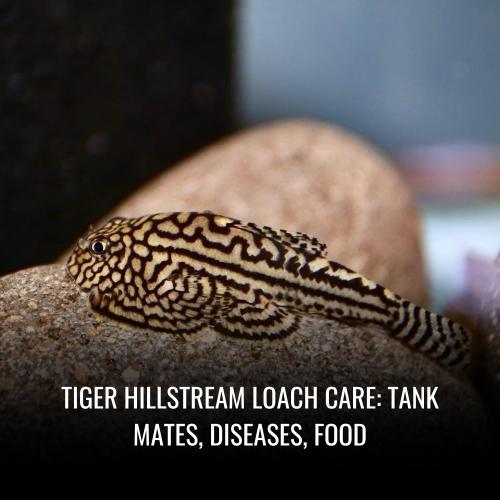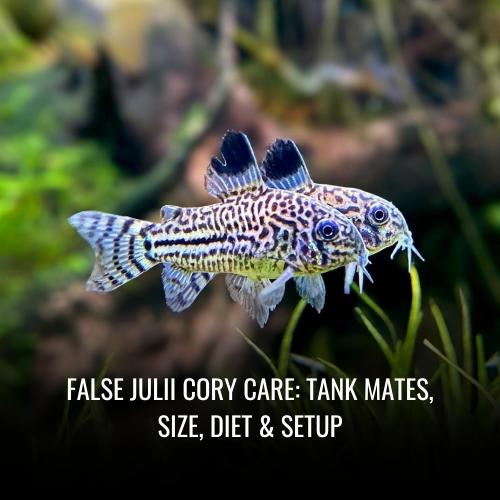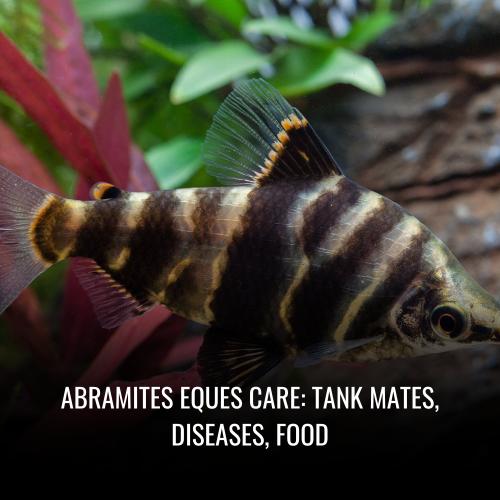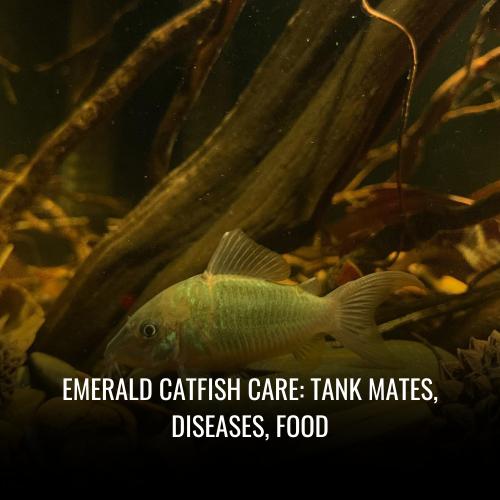Banjo catfish Care: Lifespan, Food, Tank Setup & More
This post contains affiliate links. As an Amazon Associate, we earn from qualifying purchases.
The Banjo Catfish, scientifically termed Bunocephalus coracoideus, is an intriguing bottom-dwelling fish from the family of catfishes. Its body mimics the shape of the stringed instrument, making it a fascinating addition to any freshwater aquarium. Banjo Catfish particularly thrive in environments that replicate their natural habitat such as areas with sandy or silty substrates, as they originate from the slow-moving waters of Latin America’s Amazon River and rainforest streams.
Banjo Catfish may be reclusive, but their unique behavior and appearance make them worth the patience for aquarists looking to add an unusual pet to their collection.
| Scientific Name | Bunocephalus coracoideus |
|---|---|
| Common Name | Banjo Catfish |
| Family | Bythitidae |
| Size | 2-6 inches (5-15 cm) |
| pH Range | 6.5-7.5 |
| Water Hardness (dGH) | 5-19 |
| Temperature | 73-79°F (23-26°C) |
| Reproduction | Oviparous |
| Origin | Latin America |
| Temperament (Own Species) | Peaceful |
| Temperament (Other Fish) | Peaceful |
| Tank Position | Bottom dweller |
| Lifespan | 5+ years |
| Minimum Tank Size | 30 gallons |
| Filtration System | Required |
| Sexual Dimorphism | Present |
| Substrate | Sandy/Silty |
Scientific Name
The Banjo Catfish is renowned for its scientific name, Bunocephalus coracoideus, which places it within the family Aspredinidae. This unique group of fish is part of the order Siluriformes, commonly known for its members: the catfish. What’s particularly notable about the Banjo Catfish is its membership to a larger group that encompasses 43 different species, each possessing distinctive sizes and colors.
| Kingdom | Animalia |
|---|---|
| Phylum | Chordata |
| Class | Actinopterygii |
| Order | Siluriformes |
| Family | Aspredinidae |
| Genus | Bunocephalus |
| Species | coracoideus |
Throughout Latin America, the Banjo Catfish is affectionately known by several common names like “banjo fish,” “burrowing catfish,” and “guitarrita catfish” due to its resemblance to musical instruments. Sharing the Chordata phylum with many familiar vertebrates, this fish is rooted in a lineage well-grounded in the vertebrate taxonomy.
The specific taxonomic classification not only aids scientists and hobbyists in understanding its biological characteristics but also underscores its place in the rich tapestry of aquatic life forms. Understanding its precise scientific designation is key to researching and conserving these subtle yet remarkable creatures.
Average Size
Banjo Catfish, scientifically known as Bunocephalus coracoideus, are intriguing for their distinctive morphology which mimics the appearance of a banjo. They vary considerably in size across different species within the genus Bunocephalus. The adult specimens commonly reach lengths of 5-6 inches (12.7-15.2 cm), with a maximum size of 2 to 6 inches (5 to 15 cm) for the broader genus.
Here is a brief overview of Banjo Catfish sizing:
| Classification | Average Size | Maximum Size |
|---|---|---|
| Adult | 5-6 inches (12.7-15.2 cm) | Varies by species |
| Bunocephalus Genus | 2 to 6 inches (5 to 15 cm) | Varies by species |
| B. coracoideus | Typically 2 to 3 inches (5 to 7.5 cm) | Up to 3 inches (7.5 cm) |
When purchasing these bottom-dwelling fish, they are often found at a size of 2-3+ inches (5-7.6 cm) in length. Adequate for home aquariums, these sizes reflect the manageable care Banjo Catfish require.
Their rough skin and muddied coloration are characteristic of the species, serving as an adaptation to their natural habitat and aiding in their camouflage among leaf litter and soft substrates. These attributes are consistent across the 43 known species within their family, providing them with an evolutionary advantage in the wild.
Lifespan
The Banjo Catfish, with its unique body shape and muted colors, is not only captivating to watch but also has a respectable lifespan. In a well-maintained aquarium setting, these intriguing creatures can live for about 5 to 8 years, though some Banjo Catfish have been known to exceed this range with optimal care.
Below is an overview of their lifespan:
| Environment | Average Lifespan | Note |
|---|---|---|
| In Captivity | 5-8 years | Can be longer with proper care |
| In the Wild | 8-12 years | – |
While Bunocephalus coracoideus thrive for many years under human care, their longevity is slightly overshadowed by their wild counterparts, which can live up to 8 to 12 years. This variance is likely attributed to the natural environment’s complex ecosystem benefiting these bottom-dwelling fish. In nature, the Banjo Catfish can maintain its slender bodies without the constraints of an artificial habitat.
Their durability in the wild might stem from their elusive nature; having a rough skin texture and small stature makes them less targeted for fishing and cooking, allowing them a fair chance to reach full maturity and a natural life expectancy.
Natural Habitat
Banjo Catfish (Bunocephalus coracoideus), a peculiar member of the family of catfishes, are natively found thriving in the slow-moving waters of freshwater ecosystems across Latin America. Their presence is prominent in ecosystems laden with dense debris and organic matter such as those provided by rivers, lakes, and ponds of this region.
A typical natural habitat for these bottom-dwelling fish is abundant with soft substrates like sandy or silty beds and fine gravel, encouraging their instinctual behavior to dig and forage among the leaf litter. They often utilize the cover of driftwood, rocks, and fallen leaves, particularly from the Indian almond tree, to camouflage and create secure hiding spots, demonstrating their preference for a milieu that closely resembles the rainforest streams feeding into the mighty Amazon River.
| Key Features | Description |
|---|---|
| Substrate Type | Soft sand or fine gravel |
| Additional Decor | Driftwood, rocks, dried leaf litter, caves |
| Activity Time | Nocturnal; active at night |
| Water Temperature | 72°F to 82°F |
| pH Range | 6.5 to 7.5 |
In captivity, it’s crucial to simulate these conditions, ensuring a spacious environment with the appropriate water parameters and dim lighting. Such attention to detail helps foster behaviors as seen in their natural habitats and supports their nocturnal lifestyle, especially during daylight hours when they rest within their carefully selected hideouts.
Appearance
Banjo Catfish are aptly named for their banjo-like shape; they possess a broad, flat head and elongated slender bodies. The skin of these intriguing fish is covered with a tough, keratinized layer, creating a unique, bumpy texture. Mimicking the hues of the rainforest floor, their natural coloring ranges across earthy tones—browns, yellows, and blacks—that allow them to blend seamlessly with their surroundings, often resembling tree bark.
| Key Appearance Features | Descriptions |
|---|---|
| Body Shape | Flat head with a long, slender body |
| Skin Texture | Rough, keratinized, and bumpy |
| Color | Earth tones; brown, yellow, black |
| Eyes | Small in comparison to face size |
| Horn-like Projections | From various places along the body |
Their small eyes add to their peculiar visage while their horn-like projections create an unmistakable profile. It’s fascinating to note that the Banjo Catfish’s appearance isn’t static; it can fluctuate with mood, age, gender, and social standing. When stressed, such as during shipping, these fish may temporarily lose vibrancy, resulting in a more faded appearance upon arrival in pet stores or home aquariums. This adaptive coloring is a testament to their resilience and an aspect of their enchanting charm.
Behavior & Temperament
The Banjo catfish (Bunocephalus coracoideus), with its distinctive body shape and peaceful demeanor, is a bottom-dwelling fish native to the slow-moving waters of Latin America’s waterways, such as the Amazon River and rainforest streams.
Typically reserved, they have a temperament that is well-suited to community tanks, provided their tank mates are equally peaceful. Their behavior is influenced by the soft substrates of their natural environment, which they mimic in captivity by burrowing and resting within the sandy substrate or leaf litter provided.
During daylight hours, these nocturnal creatures are elusive, often avoiding interaction by hiding in dim lighting or decorations that resemble their natural habitat. They do not display aggressive behaviors such as chasing and fin-nipping, making them a sought-after species for aquarists aiming for a harmonious tank.
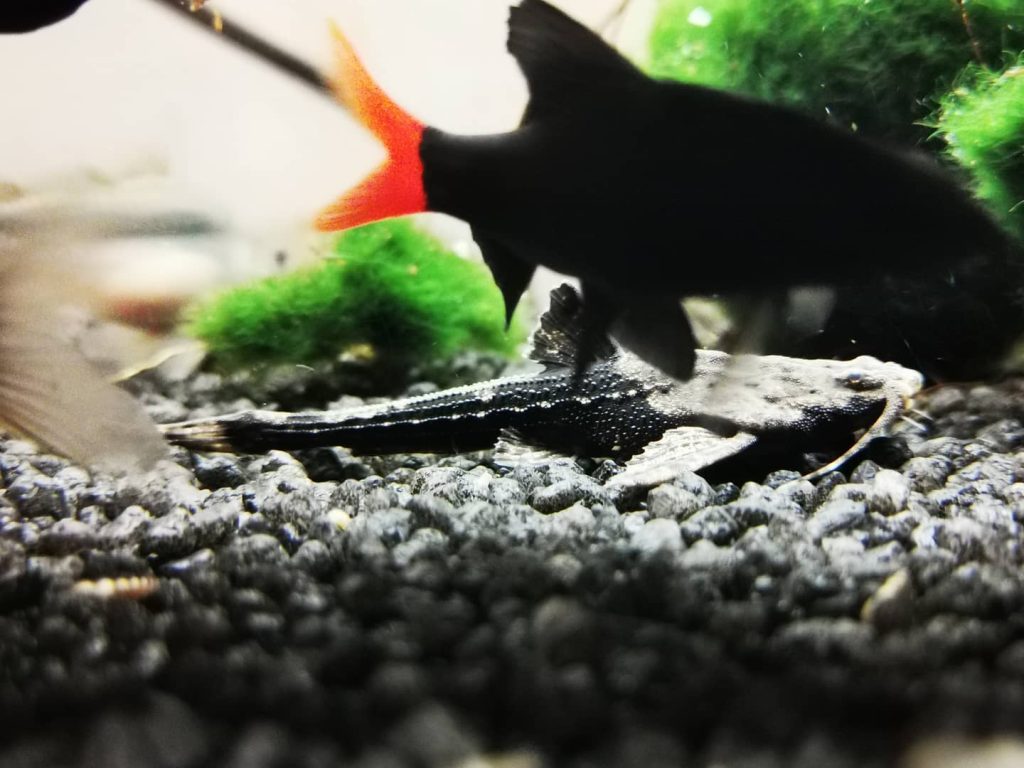
Are Banjo catfish Fin Nippers?
When it comes to community dwellings, the Banjo catfish is renowned for its tranquil nature. These shy creatures do not indulge in fin-nipping, a behavior often associated with more aggressive fish.
Their diet in captivity, which can include frozen foods like brine shrimp and white mosquito larvae, is similar to their natural diet of small invertebrates found in their habitat—further negating the need for fin-nipping as a food source.
Their passive behavior ensures they coexist amicably with other tank inhabitants, making them compatible mates for a variety of similarly-sized peaceful fish.
Are Banjo catfish Aggressive To Each Other & Other Fish?
It is quite uncommon to witness aggression amongst Banjo catfish or towards other fish. As members of a family of catfishes that favor a non-confrontational approach, they reflect a docile temperament and typically do not instigate conflicts.
However, due to their shyness, it is crucial to select compatible tank mates—those that are non-aggressive and neither so small as to be prey nor so large as to intimidate these gentle creatures. Slow-moving waters and rainforest streams have shaped their predisposition for a tranquil existence, one that they continue in the confines of a well-maintained aquarium.
Are Banjo catfish Friendly To Each Other & Other Fish?
Banjo catfish express a congenial attitude toward their kin and other fish species. They can be described as being more passive than interactive, spending much of their time engaged in solitary activities like burrowing or resting.
Nonetheless, they can be observed swimming calmly with other banjo catfish or resting near different species without signs of stress or aggression. This peaceful coexistence is indicative of their friendly nature, illustrating that they can be harmonious tank occupants when their needs for space and suitable water parameters are met.
Are Banjo catfish Schooling Fish?
Despite not being classified as schooling fish in the traditional sense, Banjo catfish do exhibit social tendencies that align them more with the description of a shoaling species. Pooling together in loose aggregations, they take comfort in the presence of their kind and display collective foraging behaviors.
This gregarious aspect of their nature does not equate to the tightly synchronized movement associated with schooling fish but rather to a sociable inclination that supports a group dynamic in their habitat.
Can You Have Just One Banjo catfish In The Tank?
While it’s possible to keep a sole Banjo catfish in a tank, aquarists often avoid this practice due to the solitary fish’s potential to experience stress and loneliness. The absence of peers can lead to a more reclusive and timid behavior, which may strain the catfish’s well-being.
Consequently, maintaining Banjo catfish individually is not recommended, as it is believed to hamper their health and decrease their lifespan. Setting up an environment that closely mirrors their natural conditions, including a community of their own species, is advised for the Banjo’s optimal welfare.
Do Banjo catfish Need To Be In Groups?
Banjo catfish thrive best when kept in groups, with a general recommendation of at least 3-4 individuals to foster a social atmosphere akin to their natural environment. The presence of conspecifics can decrease their intrinsic shyness and boost overall tank activity, especially during blue moon lighting or in other dimly lit conditions that echo their natural habitat.
Group keeping not only emulates their behavior in the wild but also consolidates their status as peaceful companions, enhancing their standard of life and promoting the display of their fascinating natural behaviors.
Food & Diet
Banjo catfish, with their intriguingly unique body shape, are not your typical herbivorous algae eaters like some other catfish varieties. Their feeding habits can be described as omnivorous and opportunistic, leading them to enjoy a varied menu in their natural habitat that consists of organic matter, small invertebrates, decaying plant material, and occasionally, algae. To ensure your Banjo catfish are receiving a well-rounded diet, it’s important to consider their natural preferences and replicate this diversity in their diet while in captivity.
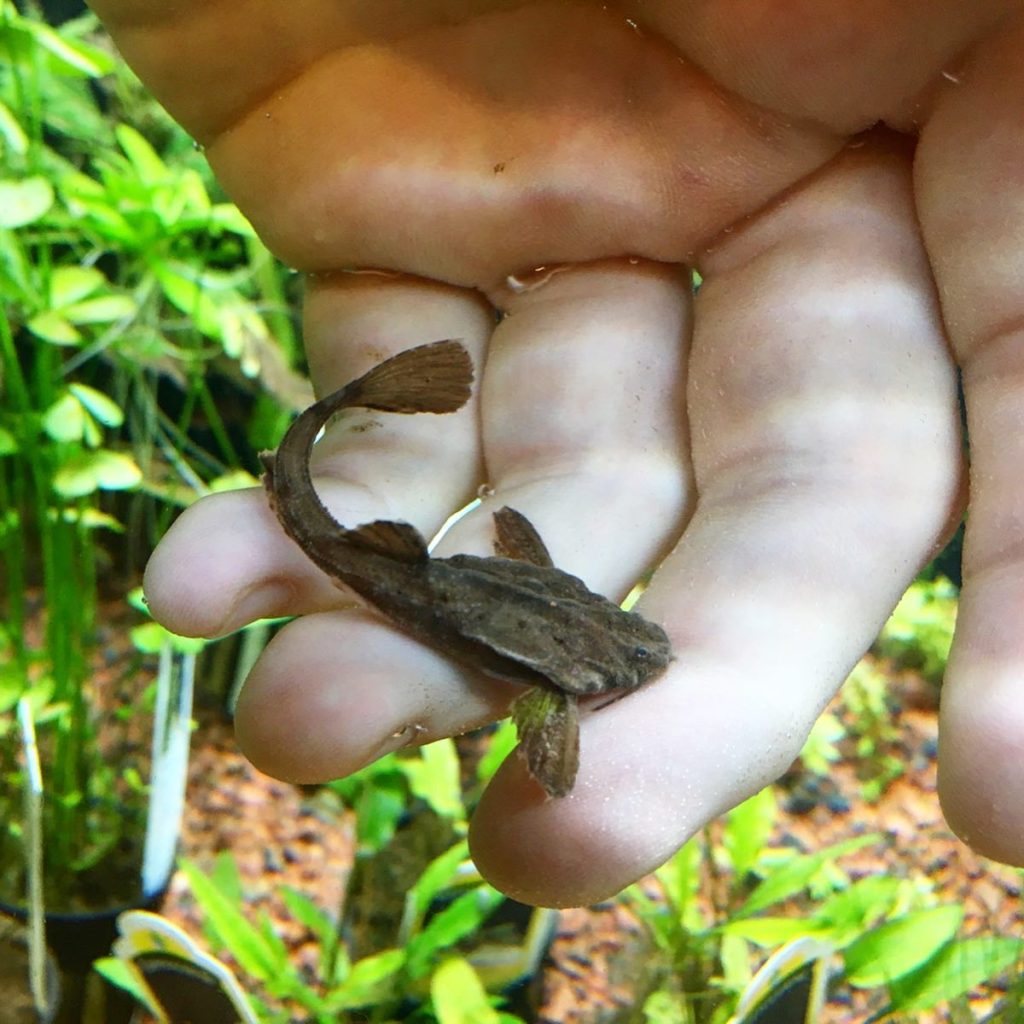
Do Banjo catfish Eat Algae?
While Banjo catfish may nibble on algae on occasion, they do not rely on it as a primary food source. Unlike certain herbivorous catfish that actively graze on algae, Banjo catfish are better categorized as omnivores that consume algae incidentally if it’s present in their environment.
However, to satisfy their nutritional needs, their diet should be supplemented with a variety of other foods that are richer in proteins and nutrients. Therefore, if looking for dedicated algae-eating fish, other species such as loaches, snails, or corydoras might be more suitable.
Do Banjo catfish Eat Shrimp?
Banjo catfish’s natural diet includes a range of small invertebrates, implying that shrimp can indeed form part of their dietary intake. If shrimp are present within their environment, these bottom-dwelling fish may consume them, especially as part of a varied diet that provides the rich proteins they need. It’s worth noting that if you plan to house shrimp and Banjo catfish together, you should consider the potential risk of the shrimp becoming a meal, especially with smaller shrimp species.
Do Banjo catfish Eat Bloodworms?
Bloodworms are a match for the kind of prey Banjo catfish would encounter in their natural environment. These meaty treats are eagerly accepted by Banjo catfish and are beneficial due to their high protein content.
Feeding Banjo catfish bloodworms, especially in the evening when they are most active, is a great way to simulate their natural feeding patterns and provide them with the rich nutrients necessary for their health. High-quality sinking catfish pellets can complement this diet to ensure that your Banjo catfish are receiving a comprehensive range of nutrients.
Do Banjo catfish Eat Mosquito Larvae?
The diet of Banjo catfish in the wild isn’t strictly plant-based; they have been observed feasting on mosquito larvae alongside other small insect larvae and invertebrates that they come across on the riverbed.
Thus, adding mosquito larvae to their diet in captivity can stimulate their natural foraging behavior and contribute to their nutritional needs. Mosquito larvae can be offered either live or frozen as an occasional treat to provide variety and ensure a balanced diet.
Do Banjo catfish Eat Planaria?
Banjo catfish are not picky when it comes to their menu choices, with planaria being no exception. As small soft-bodied invertebrates, planaria fall into the category of natural prey for Banjo catfish. In an aquarium setting, they might opportunistically feed on planaria, which often appear in over-fed tanks or those with poor cleanliness.
This makes Banjo catfish a practical choice for aquarists looking to control a planaria outbreak, although a sustainable plan should include maintaining good water quality as well.
Do Banjo catfish Eat Plants?
Contrary to some species of catfish that have a plant-based diet, Banjo catfish are not inclined to consume plants as a primary food source. While they might occasionally graze on plant matter, their diet is predominantly composed of more protein-rich foods found on the riverbed or within the water column.
Aquarists should provide a varied diet that includes both plant-material components as well as meaty foods to satisfy their dietary needs and prevent unwanted plant consumption in the aquarium.
Sexing: Male vs Female
Determining the sex of Banjo catfish, or Bunocephalus coracoideus, can often be a complex task due to the lack of pronounced gender dimorphism in this species. Visually, these fish do not exhibit strong differences between males and females, making identification a challenge without closer scrutiny.
However, size and shape may provide important clues. Females tend to be larger and have a somewhat rounder, fatter body, which may be suggestive of their reproductive role. In comparison, males are usually smaller and slimmer.
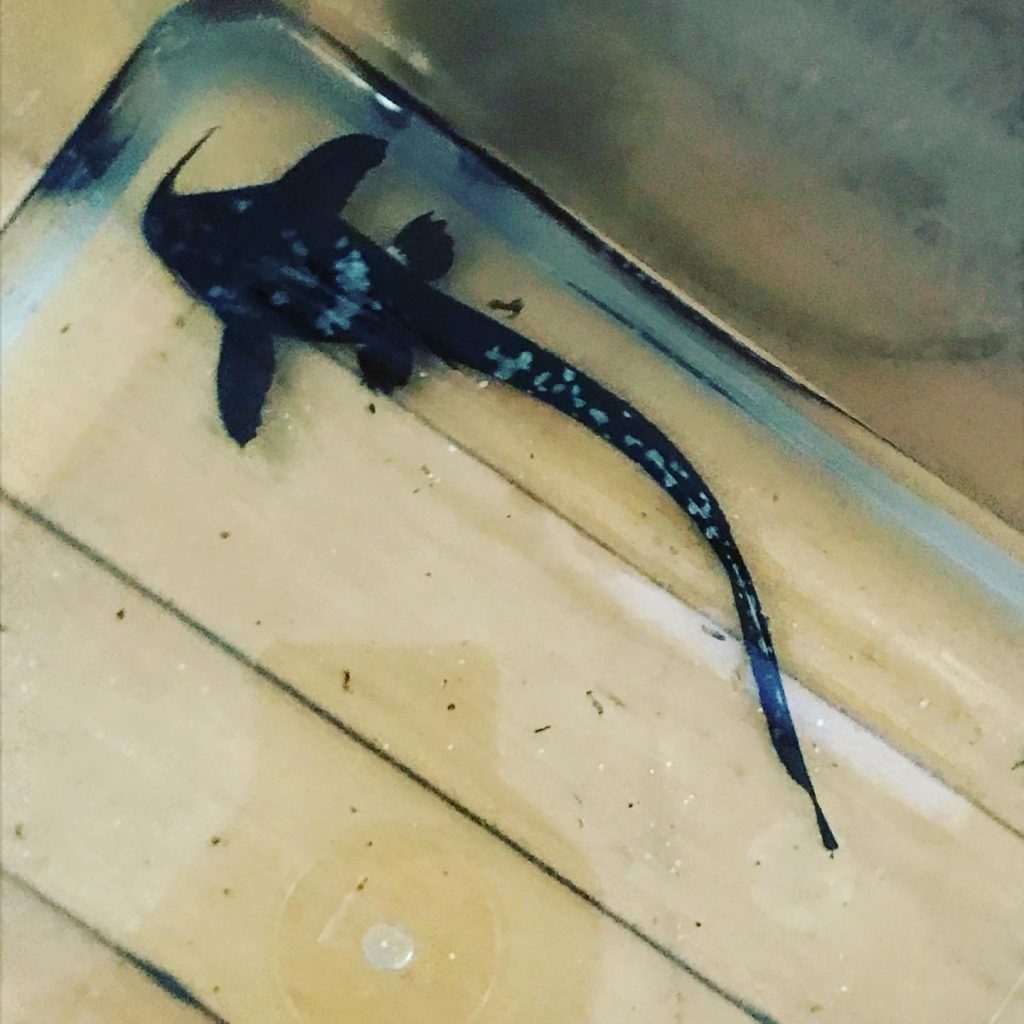
During spawning periods, behavior can be a more reliable indicator of sex. Aquarists might notice increased activity around oxygen-rich areas and water flows caused by tank filters. This heightened activity is often associated with the breeding process. Spawning might also reveal more distinctive physical and behavioral traits related to reproduction, allowing for a clearer distinction between males and females.
Gender Indicators in Banjo Catfish
| Physical Traits | Behavior During Spawning |
|---|---|
| Females: Larger, rounder body | Active swimming in oxygen-rich water |
| Males: Smaller, slender body | Distinctive behaviors near water flows |
Banjo catfish Tank Mates
When curating a community aquarium, it’s essential to select tank mates for your Banjo catfish that will forge a peaceful and harmonious environment. Due to their docile nature, the Banjo catfish will thrive with small, peaceful, and slow-moving fish that won’t act aggressively or try to make a meal out of them. A variety of suitable tank mates exist for these bottom-dwelling fish, including:
- Other Banjo catfish to keep them company
- Gentle Corydoras for bottom-level interactions
- Graceful Hatchetfish occupying the upper tank areas
- Active yet peaceful Zebrafish
- Colorful Tiger Barbs, provided they are in a school to diffuse aggression
- Serene Betta fish, keeping to a solitary specimen
- Sociable Guppies displaying a burst of colors
- Small, non-aggressive Tetras gently swimming through the tank
It is advised to avoid larger or aggressive fish species that could harm the Banjo catfish or disrupt the tranquility of their surroundings. By choosing the right tank mates, you’ll ensure the well-being and health of your Banjo catfish in a community tank setting.
| Compatible Tank Mates | Notes |
|---|---|
| Other Banjo Catfish | Provide a natural social environment |
| Corydoras | Peaceful scavengers |
| Hatchetfish | Surface dwellers, peaceful |
| Zebrafish | Active yet non-aggressive |
| Tiger Barbs (in schools) | Schooling diffuses natural aggression |
| Betta Fish (single) | Prefer calm companions |
| Guppies | Easygoing and colorful |
| Small Tetras | Gentle, good community fish |
Carefully consider each species’ character and size, ensuring they match well with the Banjo catfish’s serene lifestyle.
Aquarium Setup
Creating the perfect home for your Banjo catfish begins with implementing the right aquarium setup, which mimics their natural environment as closely as possible. It’s essential to provide an environment where these peaceful fish can thrive and exhibit natural behavior.
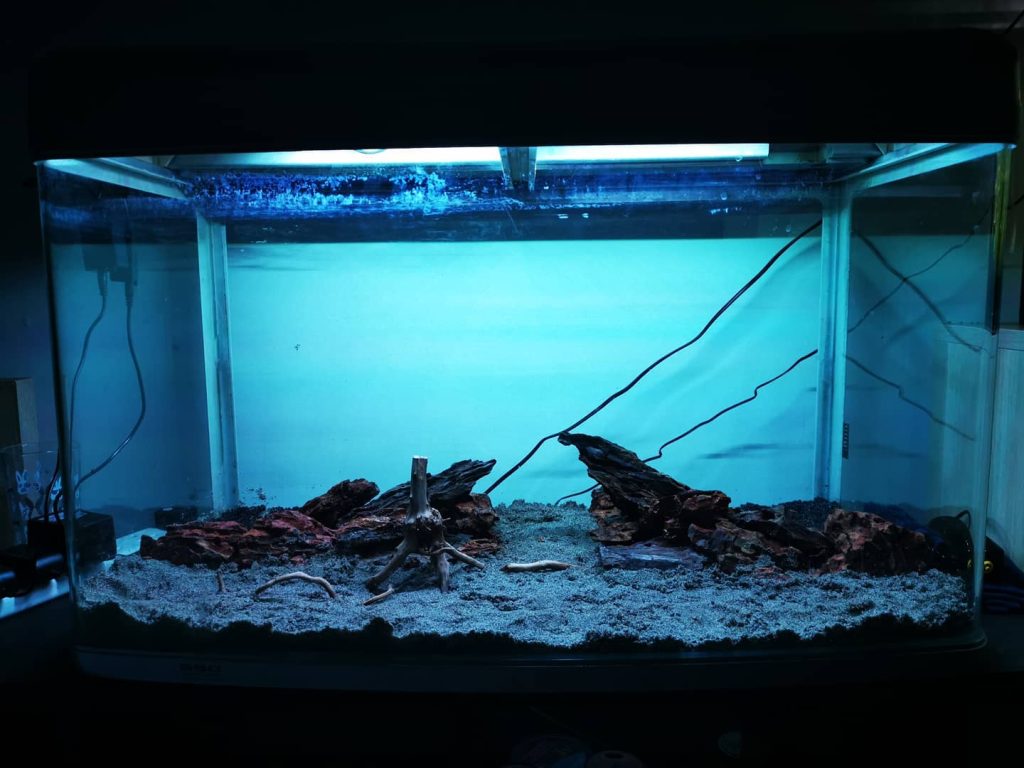
Ideal Tank Size
When it comes to tank size, Banjo catfish require enough room to swim and burrow as they would in the wild. A tank holding a minimum of 10 gallons (38 liters) of water per fish is necessary for their wellbeing. However, for these small bottom-dwelling fish, an 18-gallon tank is the minimum size recommended, with 20 gallons or more being ideal to ensure a more enriched and spacious habitat. A larger aquarium not only offers ample swimming area but also generally maintains better water quality and stability, which are critical for the health of Banjo catfish.
| Tank Size | Benefits |
|---|---|
| 10 gallons | Minimum required per Banjo catfish |
| 18-20+ gallons | Better for swimming, hiding, and water quality |
Ideal Water Parameters
Banjo catfish are adaptable but do prefer specific water conditions to stay healthy. They enjoy a temperature range of 72°F to 82°F (22°C to 28°C) and flourish in slightly acidic to neutral water with a pH of 6.5 to 7.5. The general hardness of the water should be maintained between 5 and 15 dGH, and it’s crucial to keep ammonia and nitrite levels at zero, with nitrates less than 30ppm. Regular changes, specifically the removal and replacement of 1/3 of the tank water volume with fresh water, will ensure the environment remains clean and conducive to their health.
| Parameter | Ideal Range |
|---|---|
| Temperature | 72°F to 82°F (22°C to 28°C) |
| pH | 6.5 to 7.5 |
| Water Hardness | 5 to 15 dGH |
| Ammonia | 0 ppm |
| Nitrite | 0 ppm |
| Nitrate | <30 ppm |
Filtration
Good filtration is non-negotiable when setting up an aquarium for Banjo catfish. While filtration helps to keep the water clean by removing excess food, decaying organic matter, and dangerous chemicals, it also needs to provide aeration without creating a strong current that these fish might find stressful.
Equip your tank with a filtration system that ensures constant circulation and aeration. Bear in mind that Banjo catfish are sensitive to water quality; thus, frequent partial water changes are integral to their care. Routinely renewing 1/3 of the tank water volume with fresh water aids in maintaining the water quality high and the inhabitants healthy.
| Filtration Criteria | Importance |
|---|---|
| Constant Aeration | Necessary for oxygenation and water movement |
| Gentle Water Flow | Prevents stress in Banjo catfish |
| Regular Maintenance | Ensures clean and healthy water, minimizing waste |
Lighting
The Banjo catfish’s preference for shadowy conditions calls for a nuanced approach to aquarium lighting. To simulate their preferred dimly lit environment, diffuse standard aquarium lights with floating or broad-leaved plants. An option for atmospheric ambiance could be subtle blue moon lighting, which provides a calming effect and supports the nocturnal nature of the Banjo catfish.
Avoid bright lighting as it may stress these creatures that are accustomed to subdued environments. Remember to accommodate their nighttime feeding habits with appropriate lighting that doesn’t disturb their natural patterns.
| Lighting Type | Purpose |
|---|---|
| Standard Lighting | Adequate for daytime, should be softened |
| Blue Moon Lighting | Optional for ambiance and nocturnal activity |
| Dim Environment | Best suited for Banjo catfish comfort |
With these guidelines in mind, you can create a comfortable and naturalistic aquarium for your Banjo catfish, providing a sanctuary within your home for these unique creatures to live healthily and happily.
Common Possible Diseases & Prevention
Maintaining the health of Banjo catfish in captivity is crucial to avoid common ailments such as ammonia poisoning, bloat, and skin injuries.
| Disease | Symptoms | Prevention |
|---|---|---|
| Ammonia Poisoning | Darkened color, gasping, lethargy | Regular large water changes, medication |
| Bloat | Swollen abdomen, lethargy, pale gills | Monitor diet, control feeding |
| Skin Injuries | White patches on skin | Maintain cleanliness, provide hiding spots |
By attentively monitoring water quality, regulating feeding, and ensuring a well-maintained habitat, Banjo catfish can be safeguarded against these common health issues.
Breeding Banjo catfish In Aquarium
Breeding Banjo catfish, also known as Bunocephalus coracoideus, in an aquarium setting requires attentive care and a serene environment. These bottom-dwelling fish thrive when their habitat closely mimics their natural environment, which is often the slow-moving waters of Latin America, such as the Amazon River and its rainforest streams.
To facilitate successful breeding, it’s essential to provide a tank with soft substrates, like sandy or silty substrates, and decorate it with leaf litter or dim lighting to replicate the subdued ambiance of their native habitat. A gentle introduction into such a tank helps these shy creatures gain confidence and acclimate without stress.
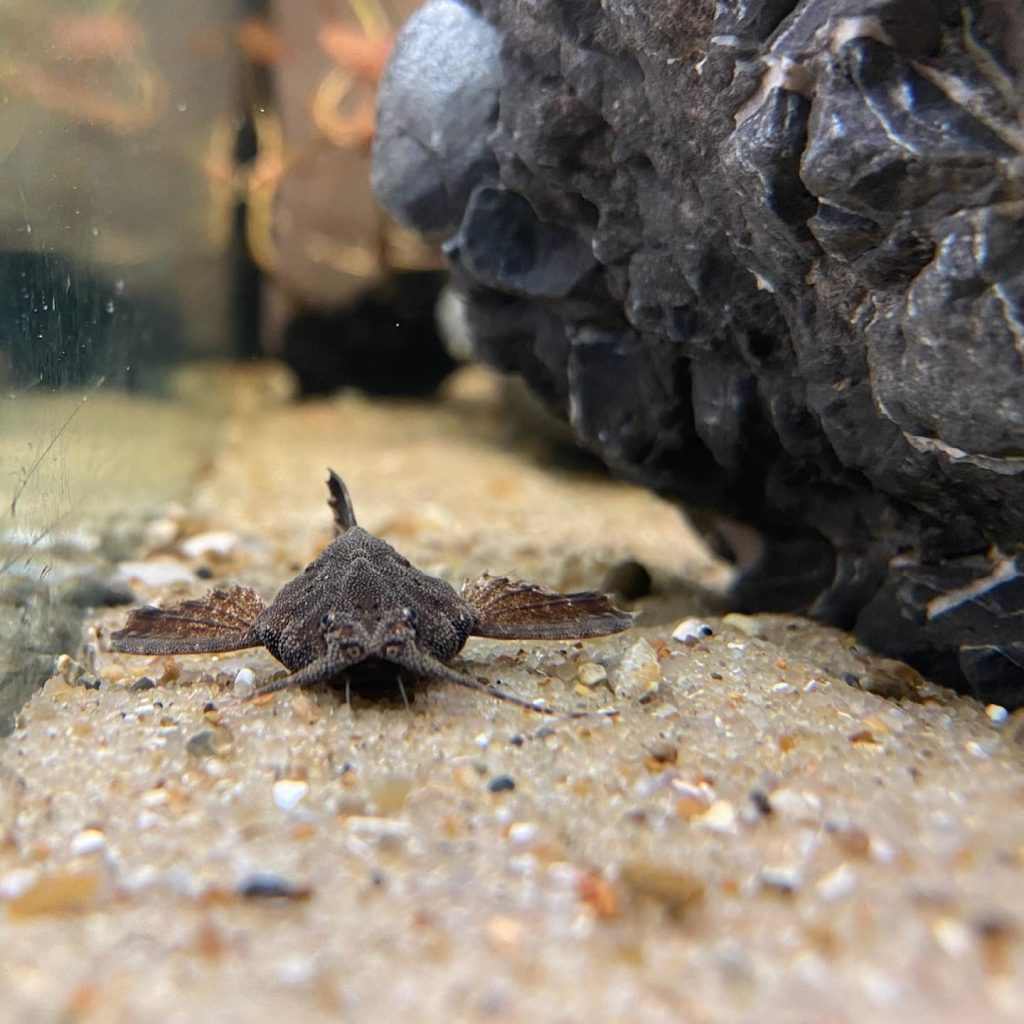
Ideal tank mates for Banjo catfish are similarly peaceful species that will not compete aggressively for food or territory. Maintaining a tranquil environment is paramount for their wellbeing and encourages breeding behavior.
After about five days from hatching, juvenile Banjo catfish begin to show their distinctive body shape and coloration. To nurture their development, relocation to a separate tank between three to five months old is advisable, and they should be switched to an adult fish diet.
| Breeding Milestones | Description |
|---|---|
| Hatchling Stage | Coloration begins after five days. |
| Juvenile Stage | Separate and start an adult fish diet at 3-5 months. |
| Adult Stage | Breeding requires peaceful, stress-free conditions. |
Are Banjo catfish Easy To Keep?
Banjo catfish, with their remarkable adaptability, are generally considered easy to care for in an aquarium setting. These hardy fish can tolerate a range of tank conditions, but they flourish in environments that mimic their natural habitats. They are at peace in dimly-lit tanks, preferring settings adorned with large broad-leafed plants, driftwood, rocks, and hidden caves. These hiding spots offer Banjo catfish the seclusion they desire during daylight hours, as they are predominantly nocturnal creatures.
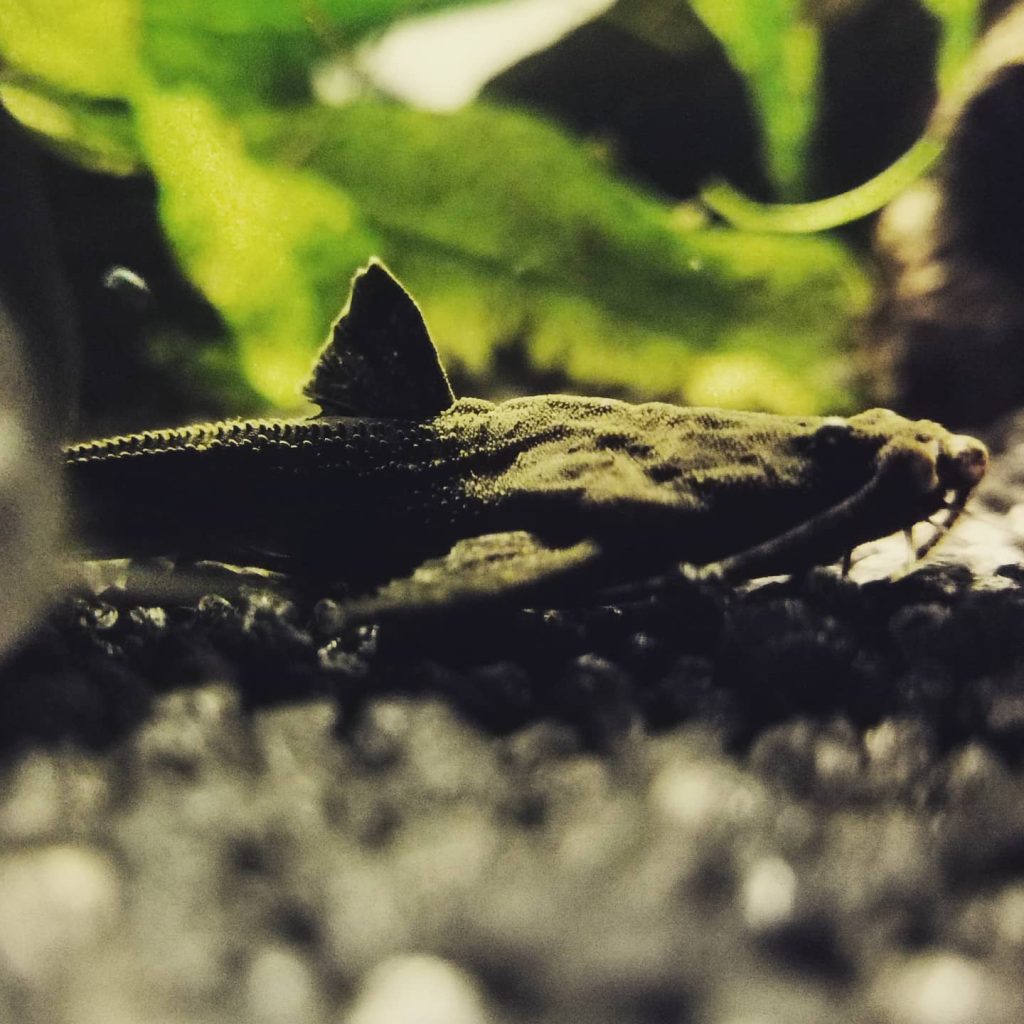
A minimum tank size of 25 gallons is recommended to provide adequate space for a Banjo catfish to roam. Water temperature should be kept consistently between 75–82°F, and the substrate should consist of soft sand or fine gravel to avoid harming their delicate barbels and underside. Weekly water changes, on the order of up to 20%, will help maintain the clean and stable conditions they prefer. It’s crucial to ensure Banjo catfish are fed in the later hours, post-dusk, as their calm demeanor might cause them to miss out on meals during the day when other tank inhabitants are more active.
| Tank Requirement | Specification |
|---|---|
| Minimum Tank Size | 25 gallons |
| Water Temperature | 75–82°F |
| Substrate Type | Soft sand or fine gravel |
| Lighting | Dim, ambient |
| Maintenance | Weekly water changes (up to 20%) |
Are Banjo catfish Sensitive To Water Changes?
Banjo catfish’s sensitivity to sudden shifts in water parameters necessitates a stable aquatic environment to thrive. Water quality, including pH levels between 6.5-7.5 and softer water conditions, should be sustained consistently to avoid stressing the fish. Sharp fluctuations in temperature or water chemistry can rapidly increase diseases’ susceptibility and diminish overall vitality.
Employing a high-quality filtration system and implementing small, regular water changes can help maintain the tank’s equilibrium. It’s also important, especially during water changes, to match the new water’s temperature and chemical makeup to the tank’s current conditions, circumventing potential stress or shock to the Banjo catfish.
| Water Parameter | Ideal Range |
|---|---|
| pH level | 6.5-7.5 |
| Temperature Consistency | Stable within 75–82°F |
| Water Hardness | Soft |
Are Banjo catfish Sensitive To Ammonia?
Ammonia sensitivity in Banjo catfish is particularly notable—these fish are especially vulnerable to high levels of this toxic compound. The byproduct of fish waste and decomposing organic matter, ammonia, in significant concentrations can induce stress, appetite loss, abnormal behavior, and severe respiratory distress for Banjo catfish, potentially leading to their demise.
Regular testing of tank water for ammonia levels is imperative for preventing these adverse effects. Maintaining an efficient balance often involves diligent filtration and periodic water changes to ensure ammonia is kept at bay for the health and well-being of Banjo catfish.
Are Banjo catfish Sensitive To Copper?
Copper sensitivity is a critical concern when caring for Banjo catfish. Copper-based treatments and medications, often used to combat various aquarium pests and diseases, can be exceedingly harmful, if not fatal, to Banjo catfish due to their low tolerance for heavy metals. Even trace amounts of copper can induce stress, illness, and worse.
To maintain a safe environment for Banjo catfish, it’s essential to avoid introducing copper into their ecosystem—whether through treatments, decorative pieces, or contaminated water sources. Regular monitoring of copper levels using reliable testing kits can prevent copper toxicity, safeguarding the precious lives of these fascinating Banjo catfish.
| Sensitivity | Details |
|---|---|
| Copper | Extremely sensitive; avoid copper-based treatments and monitor levels. |
By understanding Banjo catfish’s specific needs regarding tank conditions and sensitivities, aquarists can ensure a stress-free and healthy life for these engaging freshwater companions.


